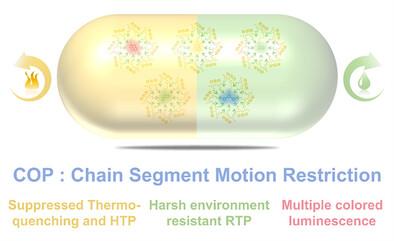空间约束与偶极相互作用间的串联约束抑制环烯烃聚合物磷光的热猝灭
IF 26.8
1区 材料科学
Q1 CHEMISTRY, MULTIDISCIPLINARY
引用次数: 0
摘要
构建刚性环境是抑制有机发色团非辐射失活和产生长寿命室温磷光(RTP)的一种成熟策略。然而,形成的刚性网络在高温下保持其稳定性是一个挑战。本文采用可控共聚法合成了一系列富酯环烯烃聚合物(cop)。来源于酯基的偶极相互作用对多环发色团的非辐射失活具有有效的抑制作用,实现了依赖于辐射的多色RTP。这些cop还能发出不错的高温磷光(HTP)。磷光热猝灭的研究表明,环骨架的空间限制可以抑制酯偶极相互作用的解离。通过进一步纳入庞大的金刚烷基,即使在湿热暴露下,也能成功地从常见的多环发色团中突破红色、黄色和绿色HTP。得益于依赖于辐照的RTP和HTP性能,所获得的cop已成功应用于湿热暴露成像、化学反应温度监测和过氧化氢检测。本文章由计算机程序翻译,如有差异,请以英文原文为准。

Tandem Restriction Between Spatial Confinement and Dipole Interaction for Suppressing Thermal Quenching of Phosphorescence from Cycloolefin Polymers
Construction of a rigid environment is a well-developed strategy for suppressing non-radiative deactivation of organic chromophores and generating long-lived room-temperature phosphorescence (RTP). However, it is challenging for the formed rigid networks to maintain their stability at elevated temperature. In this work, a series of ester-rich cycloolefin polymers (COPs) are synthesized via controlled copolymerization procedure. The dipole interactions originated from ester groups show efficient suppressing effects on the non-radiative deactivation of multi-cyclic chromophores, achieving irradiation-dependent and multi-colored RTP. These COPs can also emit decent high-temperature phosphorescence (HTP). The investigation about the phosphorescence thermal quenching reveals that the spatial confinement of the cyclic skeleton in COPs can suppress the dissociation of dipole interactions of ester. By further incorporating bulky adamantyl groups, a breakthrough in red, yellow, and green HTP from common multi-cyclic chromophores is successfully achieved, even under hygrothermal exposure. Benefiting from the irradiation-dependent RTP and HTP performance, the obtained COPs are successfully applied in imaging under hygrothermal exposure, temperature monitoring of chemical reactions, and hydrogen peroxide detection.
求助全文
通过发布文献求助,成功后即可免费获取论文全文。
去求助
来源期刊

Advanced Materials
工程技术-材料科学:综合
CiteScore
43.00
自引率
4.10%
发文量
2182
审稿时长
2 months
期刊介绍:
Advanced Materials, one of the world's most prestigious journals and the foundation of the Advanced portfolio, is the home of choice for best-in-class materials science for more than 30 years. Following this fast-growing and interdisciplinary field, we are considering and publishing the most important discoveries on any and all materials from materials scientists, chemists, physicists, engineers as well as health and life scientists and bringing you the latest results and trends in modern materials-related research every week.
 求助内容:
求助内容: 应助结果提醒方式:
应助结果提醒方式:


